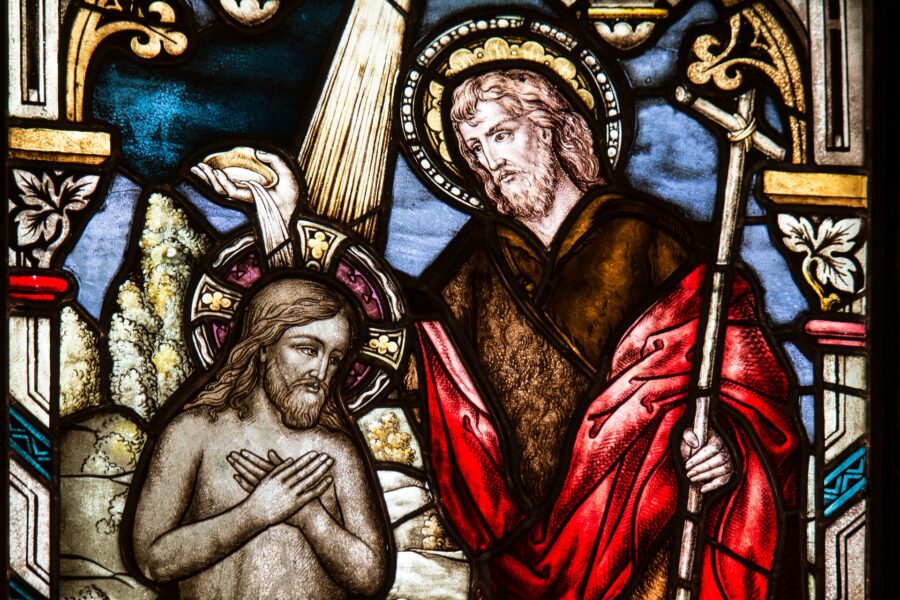Question of Origins
What are the origins of Christian baptism? A quick perusal of the biblical texts might leave one perplexed as to the sudden appearance of baptism in the New Testament.1 Immediately and without explanation one is confronted with the appearance of John “the Baptist” and the practice of baptizing in water (Matt 3:1ff). Everyone except the reader (i.e., the author of the text itself, the people in the accounts, and perhaps even the ancient audiences) seems to already be well acquainted with this ritual which requires no introduction. Where did this practice originate? Does it have any antecedents in ancient Judaism? Some scholars have thought that the baptismal practices depicted in the New Testament were derived from Jewish proselyte baptism or a similar rite. Setting aside the question of origins, what would be the significance or meaning behind ablutionary or baptismal ceremonies in general?
Purification and Renewal
Without belaboring this topic, let me just say that the common meanings and underlying significances of baptisms are purification and a change in status, particularly one of renewal. The ablutionary rite is carried out because it not only symbolizes cleansing, but it is believed to be efficacious in transforming the status of a person or object. Whether such a status is merely perceived or is passively acquired by another source, such as the water itself or God or both, becomes an important question. Physical and spiritual purification were important to ancient Jews and Christians. The physical purificatory practices were not merely hygienic. These practices were not merely symbolic. These rituals really altered reality.
Why was there such a concern about ‘impurity’ anyway? Impurity can come in many forms. The idiomatic connotations of this term in various languages remain observable throughout time. We often refer to someone or something as ‘impure,’ ‘dirty,’ or ‘unclean’ when we want to convey something negative and not necessarily in reference to physical condition. The same can be said for the use of language and communication of ancient Jews and Christians. The concept of ‘impurity’ or ‘uncleanness’ often referred to ‘sin’ or ‘wickedness’ in ancient Israel. Israel’s relationship with their God was dependent on communication and supplication untainted by the impurities of sin (socially, relationally, civilly, politically, etc.). Israel was to be a people who repudiated sin. The tabernacle (and later the temple) was structured in such a way that the priests who mediated between the people and God were required to undergo purifications of blood (animal sacrifices) and water in their approach to God. If Israel was obedient and maintained orderly purity, then God’s spirit would remain in their midst and dwell amongst them. Thus, the ablutionary practices involved in the Levitical cult served to purify and renew its participants with the assumption that spiritual impurity (i.e., sin) would not interfere with the mediation between Israel and God.
One can begin to see some possible origins of Christian baptism, but how did it go from Hebrew priests washing themselves in a brazen laver (Exod 30:17–21) or other cultic purity rites (Lev 14–15; Num 19) to any willing person to be baptized ‘in the name of Jesus’? Are these practices even related? The closest thing we see in the Hebrew bible to a non-priest being ‘baptized’ is the account of Naaman, a gentile military commander suffering from leprosy, who immerses in the Jordan river at Elisha’s command (2 Kgs 5:1–19). While Naaman is not practicing an ablutionary ritual for cultic purposes in the same manner as the Israelites, Naaman’s immersions are intended for a change in status—from leprosy to a purified state. Naaman baptizes for the sake of a renewal (see in particular vv. 10 and 14).
What could have occurred between times of the Hebrew bible and the New Testament (often referred to as the Intertestamental Period) that the common Jewish people thought it an acceptable practice to engage in baptismal practices, such as John the Baptist’s baptism for repentance (Mark 1:4; Acts 13:24)? There are actually quite a bit of hints ‘sprinkled’ throughout the New Testament and Deuterocanonical literature. (I trust you got that ‘sprinkled’ joke… yes, the puns are strong with this one). A reference to washing oneself at the appointed festivals before presenting offerings is found in the book of Jubilees 21:16.2 Other instances of washing appear in Testament of Levi 9:11, Ordinance of Levi 1:19–26, 53–54, and the Prayer of Levi. Judith 16:18 alludes to a purification rite performed by the common people and without a waiting period (which is required by the Torah). People are described as washing their hands in a river before prayer in the Letter of Aristeas 305–307. A passage in the Sibylline Oracles links full body washing with repentance, but this is likely a result of Christian influence (4:162–170).
In Mark 7 we have an account of Jesus being confronted about his disciples eating with ‘unwashed hands’. The beginning of this passage is worth quoting:
“The Pharisees and some of the scribes gathered around Him when they had come from Jerusalem, and had seen that some of His disciples were eating their bread with impure hands, that is, unwashed. (For the Pharisees and all the Jews do not eat unless they carefully wash their hands, thus observing the traditions of the elders; and when they come from the market place, they do not eat unless they [b]cleanse themselves; and there are many other things which they have received in order to observe, such as the washing of cups and pitchers and copper pots.) The Pharisees and the scribes asked Him, ‘Why do your disciples not walk according to the tradition of the elders, but eat their bread with impure hands?’” (Mark 7:1–5)
The washing of hands before eating bread is not quite the same as dunking oneself in a river of water. Nevertheless, these practices are indeed related as we shall see. The Torah prescribed washing in water (Exod 30:17–21; Lev 14–15; Num 19) and in some cases it was clear that mayim chayim/ha’mayim ha’chayim, translated ‘living waters’ (Lev 15:13; Deut 21:4) was required for proper purification. There has been some debate regarding to what exactly this phrase might refer. Some have theorized that it refers to natural water, or water in which living things reside (e.g., fish), but it is most likely speaking of waters which are ‘moving’ or ‘running’ (cf. Lev 14:5–6, 50–52). This does not exclude natural water or water in which living things reside. In fact, one would ‘naturally’ (again, pun intended) go to such water sources which are expected to be ‘moving’ or ‘running’. In some of these circumstances, the command to wash in water or ‘living water’ was applicable to the common people (in cases of menstruation, emissions, contact with a corpse, or other physical conditions). As time elapsed the Jewish people began to permit ablutionary practices in preparation for various activities, such as eating bread as we have seen in Mark 7 (par. Matt 15). Jewish ritual ablutions took many forms and could include either full body immersions or just the washing of hands or feet. Due to the need to ensure that immersions were done in suitable water, immersion pools known as miqwaʾôt were constructed (miqwah, sg.; this word means ‘collection’ as in a ‘collection of water’ into one place). Miqwaʾôt were designed to draw water through channels/aqueducts from natural water sources to ensure that the water was ‘moving’. There were even specific measurement requirements determined to ensure that a full immersion could take place. If a person so desired, she could still immerse in a completely natural water source as a river, sea, or ocean. Not only people, but objects were also immersed for the sake of ritual purification. Miqwaʾôt have been discovered also at Qumran and appear to have been used for repetitious ablutions.
By the time of the first century CE (the time of John the Baptist and Jesus), the presence of miqwaʾôt in Israel was a commonplace and the practice of immersing in water or washing hands [ritualistically] was well implemented. Two possible ritual immersion pools mentioned in the New Testament are the Pool of Bethesda (John 5:2) and the Pool of Siloam (John 9:7). The confines of washing for purposes only outlined in the Torah were expanded, or at least reinterpreted, to include ablutions for various purposes of purification or renewal affecting a change in status. An entire mishnaic tractate is dedicated to the regulations for suitable ritual baths and proper practices (m. Miqwaʾot). Ritual hand-washing is well attested in early rabbinic Judaism also with an entire mishnaic tractate dedicated to the legalities of the practice (m. Yadayim; “hands”).
John’s baptism of repentance does not appear to have been a repetitious ritual, but a one-time rite of spiritual purification symbolizing a change in one’s way of life [in connection with the judgement of God]. Those who practiced and transmitted the baptism of John did so for preparation and renewal. The baptism of Jesus (that is, baptizing those who follow Jesus and his teachings) followed that of the baptism of John. It is the baptism of Jesus that has become what I refer to as ‘Christian baptism’. This is the baptism that Christians have practiced since the first century CE. It is unlikely that Christians utilized miqwaʾôt for the baptisms of John and Jesus; gentiles who were not considered authentic converts to Judaism would probably not have been permitted in miqwaʾôt. Instead, natural water sources were sought for these non-repetitious ceremonies. Christian baptism symbolizes a change in status—a new way of life. The new Christian is renewed from a previous way of life. Ultimately, Christian baptism derives its origins from Jewish ablutionary practices and shares the underlying significances of purification, change, and renewal.
Jewish Proselyte Baptism: Antecedent or Anachronism?
As aforementioned, some scholars have suggested that Jewish proselyte baptism was the basis for Christian baptism. If gentiles were baptized during their conversion process to Judaism, then it makes sense that the earliest Christians (being mostly Jews initially) merely continued this practice, but instead in a conversion of life to following Jesus as the Messiah. Baptism for Jewish proselytes is not prescribed in the Hebrew bible. Circumcision is required for male converts (Gen 17:10–14; Exod 12:42–51; Lev 12:3). Females, however, have no clear ordinance for conversion. It is thought that baptism was practiced for females in the proselytization process and then extended to males. A certain passage in the Mishnah, m. Pesaḥ. 8:8 (cf. m. ʿEd. 5:2; par. t. Pisha 7:14), is the most cited reference for demonstrating that Jewish proselytes participated in a baptism during conversion:
“A mourner has a ritual bath and may eat of his Passover offering in the evening, but not of the sacrifices. He who learns of the death of his kinsman, and he who assembles the bones [of his parent], has a ritual bath and may eat the sacrifices. A proselyte who was proselytized on the eve of Passover—the School of Shammai say, He has the ritual bath and eats of his Passover offering in the evening; but the School of Hillel say, One who separates from the uncircumcised is as one who separates from the grave.”3
This passage had for a long time been the locus classicus for proof of Jewish proselyte baptism in the Mishnah. However, this passage discusses a difference of views between the Schools of Hillel and Shammai regarding the suitability of a person to eat the Passover offering. If a person is undergoing conversion and will be presenting an offering, when must he/she immerse and how long must he/she wait in order to be purified for the sake of the offering? The School of Shammai takes a more lenient stance in this case, which is a rarity. The School of Hillel requires a longer waiting period. With this context understood, the passage can no longer be seen as a discussion about the stages a gentile goes through in becoming a Jew. The interpretation of this passage as referring to ‘proselyte baptism’ as an identifiable rite or as an initiatory rite is an error. The use of this passage as evidence for an early practice of Jewish proselyte baptism is a simply a mistake.
Aside from this passage, the Mishnah lacks mention of any type of ‘proselyte baptism’. If we go forward in time and look at the Talmudic literature, we discover explicit references to baptizing proselytes. Some of the earliest references appear in b. Yebam. 46a–48b. In one particular section, there is a discussion about the instructions given to a candidate for conversion. If the candidate accepts the instructions, he is circumcised and then baptized shortly thereafter while given further instructions:
“If he accepted, he is circumcised forthwith… As soon as he is healed arrangements are made for his immediate ablution, when two learned men must stand by his side and acquaint him with some of the minor commandments and with some of the major ones. When he comes up after his ablution he is deemed to be an Israelite in all respects.” (b. Yebam. 47a–b)
This evidence from the Babylon Talmud appears to allude to an initiatory rite of proselyte immersion. This passage happens to be a baraita, which is a talmudic passage usually beginning with a phrase such as “Our rabbis [have] taught” or a teaching given by a named rabbi given in the name of another rabbi who lived in the second century CE or prior. Much of this material is thought to be of Palestinian origin and have been preserved and transmitted orally and fairly accurately. A baraita is typically seen as old and trustworthy material (in terms of teachings) in the Talmud. While the Talmud which contains this passage was compiled around 500 CE, this particular section probably dates to the end of the second century CE. This is still quite some time after the early first century CE when Christianity arose (keeping in mind the momentous event of the Temple’s destruction in 70 CE with the rippling effect of changes it brought to Jewish beliefs and practices). A survey of Talmudic references to what we might identify as ‘proselyte baptism’ does not reveal that this practice was a rite in itself (as opposed to a necessary step prior to presenting an offering, for instance) until later than the first century CE, and therefore after the inception of Christianity. If there is any such incipient form of the rite, it would certainly date post-70 CE. The silence of the Mishnah on this practice is quite telling. Much of the Mishnah’s content describes beliefs or practices which we can confidently date to before the first century CE. With this in mind and with the stretching of our earliest Talmudic references back to the second century CE, it is almost certain that what later became known as Jewish proselyte baptism was not an antecedent to New Testament or Christian Baptism. It would be anachronistic to claim influence of this later practice on the baptisms we read about in the New Testament.
What Baptism Means to You
Chances are if you ask a typical person what baptism means, you will not receive a response detailing Hebrew cultic purificatory ablutions. That’s OK. The answer of origins is not always the answer to everything. I don’t encourage an eradicating or complete overriding of origins in making anything relevant to people throughout time, and it is undoubtedly important to understand origins, antecedents, and the past. It is also important to realize that reception of people and practices is at work within our interpretations, performances, and transmission (Wirkungsgeschichte).
Even within the New Testament we observe multiple purposes of baptism by different authors. Mark indicates that John’s baptism was one “of repentance for the forgiveness of sins” (Mark 1:4). In Luke’s account of Peter’s sermon at Pentecost baptism is said to be done “in the name of Jesus Christ for the forgiveness of your sins” and is tied to repentance and the gift of the Holy Spirit (Acts 2:38). Paul connects baptism with the death, burial, and resurrection of Jesus, but also emphasizes the newness of life that comes about as a result:
“What shall we say then? Are we to continue in sin so that grace may increase? May it never be! How shall we who died to sin still live in it? Or do you not know that all of us who have been baptized into Christ Jesus have been baptized into His death? Therefore we have been buried with Him through baptism into death, so that as Christ was raised from the dead through the glory of the Father, so we too might walk in newness of life. For if we have become united with Him in the likeness of His death, certainly we shall also be in the likeness of His resurrection, knowing this, that our old self was crucified with Him, in order that our body of sin might be done away with, so that we would no longer be slaves to sin; for he who has died is freed from sin.” (Rom 6:1–7)
The New Testament Gospels do not tie baptism to the death, burial, or resurrection of Jesus (with the possible exception of Mark 10:38–39, but this is disputed). It was Paul, in his reception of the baptism of Jesus, who makes this connection. This does not negate the purpose of baptism for repentance and the forgiveness of sins. In fact, Paul’s preceding discussion is in regards to the cessation of living in sin, which is repentance. Paul’s mentioning of ‘grace’ here is connected to forgiveness. He also explicitly mentions the beneficial consequence of baptism as a newness of life.
I have heard Christians say that baptism is an outward expression of one’s decision to follow Jesus. I have heard Christians say that baptism is an illustration and imitation of Jesus’ death, burial (descending into the water), and resurrection (ascending out of the water). I have heard Christians say that baptism is for the purpose of signifying a person becoming part of the Body of Christ (becoming party of the Church). Probably the most common answer given by Christians and non-Christians would be that baptism is just a ceremony that is part of becoming a Christian. These and similar explanations are neither unfounded nor unbiblical. Like the New Testament authors, Christians throughout time and today receive baptism with certain explanations or emphases. As long as the underlying purpose and significance of baptism are retained, then Christian baptism is not undermined. Ultimately, all of these explanations imply repentance, forgiveness of sins, and a renewal or newness of life.
Immersed in Baptism
The topic of baptism can be investigated from many different angles: One could look into its ancient origins or its modern interpretations; one could research its cultic and sociological developments or ponder the theological significances of this ancient rite. It is one of the most significant and symbolic rites of Christendom. It is an integral element of Christianity in which Christians are immersed. And with this, I would like to end with a fitting and pertinent quotation to inspire us all:
“I’m a little concerned right now. About… your salvation and stuff. How come you have not been baptized?” –Nacho, Nacho Libre
Endnotes
- If one reads in the traditional canonical order as opposed to, for example, a chronological order of authorship.
- Unless otherwise noted, all quotations or citations of OT Pseudepigrapha are taken from The Old Testament Pseudepigrapha, 2 vols., ed. James H. Charlesworth (Peabody: Hendrickson Publishers, 2009); Charlesworth dates Jubilees to 161–140 BCE (The Old Testament Pseudepigrapha, 2:43–44).
- Unless otherwise noted, all quotations or citations of the Mishnah are taken from Philip Blackman, ed., Mishnayoth, 7 vols. (New York: The Judaica Press Inc., 1963–1964); all quotations or citations of the Babylonian Talmud are taken from Isidore Epstein, ed., The Babylonian Talmud, 1935–1952 (35 vols.), (repr. 18 vols., London: Soncino Press, 1961).





Leave a Reply
Your email is safe with us.